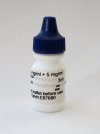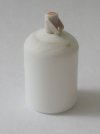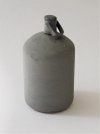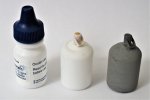David1226
Registered
I.P.Black, Coal Merchant of Gernies End on the Claptowte Railway, as well as dealing in coal, coke and logs, is also an agent for Calor Gas. I was therefore in need of some G Scale Calor Gas bottles. I searched the internet and found countless 3D printed examples of modern propane, butane and other gas bottles in all shapes and sizes, but nothing that fulfilled my requirements. What I was looking for was an example of the1950/60s style of Calor Gas bottle that I remember from my youth and countless Summers spent at my Grandparents caravan on the South Coast.
As a sufferer of glaucoma, I have been required to use two types of eyedrops on a daily basis. The bottles are similar but there is a slight size difference. It occurred to me that, with a bit of modification, the smaller of the two was pretty much the ideal size for a G Scale Calor Gas bottle.

The first job was to peel off the self adhesive label then put a razor saw through the neck and discard the top. The saw cut is then squared off and cleaned up. Next an offcut of 2.0mm thick plasticard, trimmed to be roughly circular, is superglued over the cut hole. When set, the plasticard is then filed and sanded to produce the dome shaped top to the bottle.
The screw on cap of the Calor Gas bottle, which serves to protect the bottle valve and also a carrying handle, should ideally be cut from a piece of plastic rod. I had no solid rod of a suitable diameter so I glued a length of wooden kebab skewer inside a length of plastic tube. The end of this composite rod was then slightly rounded at the tip and a short length glued on the top of the dome. The carrying handle was formed from a length of thin plasticard. The finished bottle was given a coat of spray plastic primer and then painted.
I am frustrated to think of how many bottles I have thrown away over the years as I can only make one new Calor Gas bottle a month.



David
As a sufferer of glaucoma, I have been required to use two types of eyedrops on a daily basis. The bottles are similar but there is a slight size difference. It occurred to me that, with a bit of modification, the smaller of the two was pretty much the ideal size for a G Scale Calor Gas bottle.

The first job was to peel off the self adhesive label then put a razor saw through the neck and discard the top. The saw cut is then squared off and cleaned up. Next an offcut of 2.0mm thick plasticard, trimmed to be roughly circular, is superglued over the cut hole. When set, the plasticard is then filed and sanded to produce the dome shaped top to the bottle.
The screw on cap of the Calor Gas bottle, which serves to protect the bottle valve and also a carrying handle, should ideally be cut from a piece of plastic rod. I had no solid rod of a suitable diameter so I glued a length of wooden kebab skewer inside a length of plastic tube. The end of this composite rod was then slightly rounded at the tip and a short length glued on the top of the dome. The carrying handle was formed from a length of thin plasticard. The finished bottle was given a coat of spray plastic primer and then painted.
I am frustrated to think of how many bottles I have thrown away over the years as I can only make one new Calor Gas bottle a month.



David
